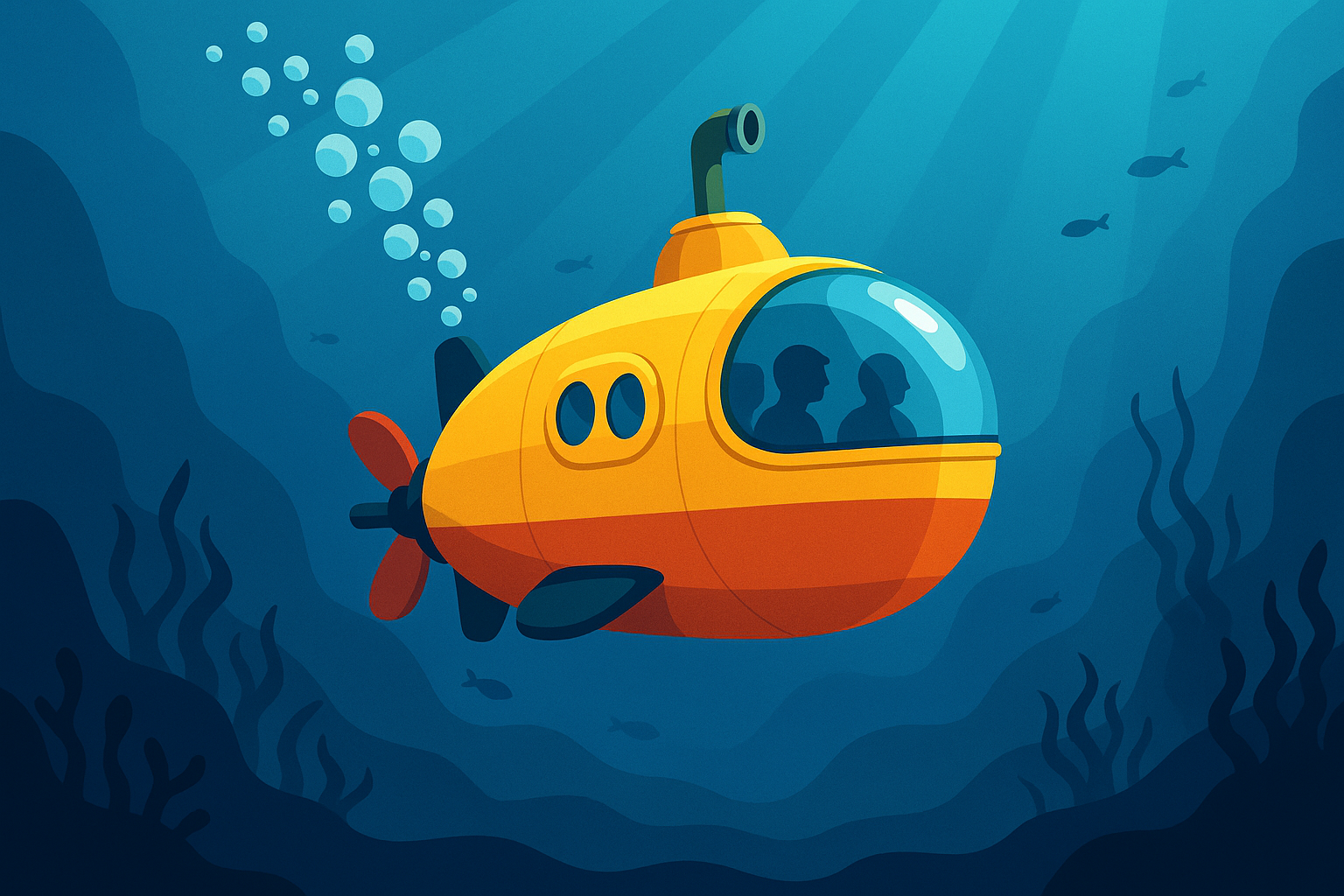
Excerpt
Introduction: Dive In!
You’re inside a narrow hallway that smells faintly like metal and something like boiled eggs. The lights are low, the walls curve around you, and every footstep echoes. Behind one door, someone’s fixing wires. Behind another, someone’s snoring in a bunk that looks barely bigger than a sleeping bag. There’s no window. There’s no fresh air. And above your head? About 200 feet of cold ocean water pressing down.
Welcome to submarine life.
Living in a submarine isn’t just about being underwater. It’s about building a whole world under the sea where people can sleep, eat, work, and stay alive without ever stepping outside. And here’s the wild part: some people do this for weeks. Others? They might stay down for three whole months without surfacing once.
Inside the sub, everything is tightly packed. There’s no extra space—no backyards, no long hallways, no “I’m going to go take a walk” time. Beds are stacked like bookshelves, three or four high. Most aren’t even called beds—they’re called bunks. And you don’t get your own unless you’re really lucky. In many submarines, two or even three people share the same bunk, just at different times. That’s called hot bunking. You sleep while someone else is working, and when you’re up, they crawl into the same spot you just left.
Now, what about meals? There are no fast-food places 800 feet underwater. Everything has to be stored before the mission even starts. There are fridges, freezers, and shelves stuffed with cans. In the first few days, you might get fresh fruit or bread. After that, it’s a lot of powdered eggs, boxed milk, and things that don’t go bad easily. And guess what? Every inch of storage counts. Even the tiny spaces under the floor can be filled with food.
There’s a cook, and maybe a small team to help. But don’t expect a giant kitchen. The galley—the sub’s kitchen—is usually the size of a closet. And still, people eat three meals a day, every day, while the sub cruises silently through the ocean.
Now here’s something to think about: how do people breathe underwater for that long? There’s no magic involved, but there is science. Submarines have special machines that take carbon dioxide out of the air and add oxygen back in. It's like having a fake forest on board, keeping the air clean and safe. Without those systems, it would get dangerous really fast.
But even with fresh air and food, things can get tricky. Ever been stuck inside on a rainy day and felt kind of grumpy after just a few hours? Try being underwater with the same 100 people, 24 hours a day, with nowhere else to go. People get tired. They get cranky. They miss their families and the sky and the wind. That’s why submariners—people who work on subs—learn how to stay calm, patient, and polite even in tight spaces.
Time is different down there, too. There’s no sunrise or sunset to show what part of the day it is. Inside, the lights stay the same. That means everyone has to follow a schedule, even when their body wants to be confused. There are shifts, just like at a factory or hospital. One group might work from midnight to 6 a.m. while another sleeps or cleans. And then they switch.
Now imagine trying to stay healthy in all of this. There’s no gym, but there’s usually at least one tiny workout room with weights or a treadmill strapped to the floor. You need it. Moving your body helps your brain feel better, especially when there’s no sun, fresh air, or open space.
And speaking of your brain—boredom is real. Submariners play cards, watch movies on laptops, or read books. Some write journals. Some just daydream about what they’ll eat when they’re back on land. What would you miss the most?
Being underwater for a long time isn’t always quiet, though. Even when a submarine tries to be stealthy, there's noise. The hum of the engine. The clank of tools. The beeping of machines. The whoosh of air moving through vents. And every once in a while, a loud alarm might go off for a drill. Not a real emergency, just practice. But it still gets your heart racing.
Sometimes the sub rises close to the surface to get new messages from above. That’s when the outside world checks in—news from home, emails, even sports scores. Other times, you’re completely cut off. No texting. No calling. No streaming videos. You’re alone with your thoughts and your crew.
And yet, for all the challenges, people volunteer for this life. Why? Because it’s an adventure. Because it's important. Because it feels like being part of something few others get to experience. Some are in the military, doing missions for their country. Others are scientists, studying the ocean or helping with research. No matter their reason, they all have to be strong in body and mind.
There are rules to follow and routines to stick to. Everyone has a job. Everyone helps. One person might be steering. Another might be fixing pipes. Someone else might be watching sonar screens for signs of underwater obstacles. Every job matters. If one thing breaks, the whole team jumps in to fix it.
And sometimes, in the middle of the ocean, deep underwater, strange things happen. Maybe it’s a glowing jellyfish outside the hull. Maybe it’s a sonar ping bouncing off something no one can identify. Or maybe it’s just the way the sub creaks and shifts like it’s alive.
You can’t knock on the wall and hear the ocean. But you can feel the pressure of the deep all around you. It’s like being inside a metal bubble, hiding from the crushing force of water that wants to squish anything not strong enough to hold its shape.
You’re inside a narrow hallway that smells faintly like metal and something like boiled eggs. The lights are low, the walls curve around you, and every footstep echoes. Behind one door, someone’s fixing wires. Behind another, someone’s snoring in a bunk that looks barely bigger than a sleeping bag. There’s no window. There’s no fresh air. And above your head? About 200 feet of cold ocean water pressing down.
Welcome to submarine life.
Living in a submarine isn’t just about being underwater. It’s about building a whole world under the sea where people can sleep, eat, work, and stay alive without ever stepping outside. And here’s the wild part: some people do this for weeks. Others? They might stay down for three whole months without surfacing once.
Inside the sub, everything is tightly packed. There’s no extra space—no backyards, no long hallways, no “I’m going to go take a walk” time. Beds are stacked like bookshelves, three or four high. Most aren’t even called beds—they’re called bunks. And you don’t get your own unless you’re really lucky. In many submarines, two or even three people share the same bunk, just at different times. That’s called hot bunking. You sleep while someone else is working, and when you’re up, they crawl into the same spot you just left.
Now, what about meals? There are no fast-food places 800 feet underwater. Everything has to be stored before the mission even starts. There are fridges, freezers, and shelves stuffed with cans. In the first few days, you might get fresh fruit or bread. After that, it’s a lot of powdered eggs, boxed milk, and things that don’t go bad easily. And guess what? Every inch of storage counts. Even the tiny spaces under the floor can be filled with food.
There’s a cook, and maybe a small team to help. But don’t expect a giant kitchen. The galley—the sub’s kitchen—is usually the size of a closet. And still, people eat three meals a day, every day, while the sub cruises silently through the ocean.
Now here’s something to think about: how do people breathe underwater for that long? There’s no magic involved, but there is science. Submarines have special machines that take carbon dioxide out of the air and add oxygen back in. It's like having a fake forest on board, keeping the air clean and safe. Without those systems, it would get dangerous really fast.
But even with fresh air and food, things can get tricky. Ever been stuck inside on a rainy day and felt kind of grumpy after just a few hours? Try being underwater with the same 100 people, 24 hours a day, with nowhere else to go. People get tired. They get cranky. They miss their families and the sky and the wind. That’s why submariners—people who work on subs—learn how to stay calm, patient, and polite even in tight spaces.
Time is different down there, too. There’s no sunrise or sunset to show what part of the day it is. Inside, the lights stay the same. That means everyone has to follow a schedule, even when their body wants to be confused. There are shifts, just like at a factory or hospital. One group might work from midnight to 6 a.m. while another sleeps or cleans. And then they switch.
Now imagine trying to stay healthy in all of this. There’s no gym, but there’s usually at least one tiny workout room with weights or a treadmill strapped to the floor. You need it. Moving your body helps your brain feel better, especially when there’s no sun, fresh air, or open space.
And speaking of your brain—boredom is real. Submariners play cards, watch movies on laptops, or read books. Some write journals. Some just daydream about what they’ll eat when they’re back on land. What would you miss the most?
Being underwater for a long time isn’t always quiet, though. Even when a submarine tries to be stealthy, there's noise. The hum of the engine. The clank of tools. The beeping of machines. The whoosh of air moving through vents. And every once in a while, a loud alarm might go off for a drill. Not a real emergency, just practice. But it still gets your heart racing.
Sometimes the sub rises close to the surface to get new messages from above. That’s when the outside world checks in—news from home, emails, even sports scores. Other times, you’re completely cut off. No texting. No calling. No streaming videos. You’re alone with your thoughts and your crew.
And yet, for all the challenges, people volunteer for this life. Why? Because it’s an adventure. Because it's important. Because it feels like being part of something few others get to experience. Some are in the military, doing missions for their country. Others are scientists, studying the ocean or helping with research. No matter their reason, they all have to be strong in body and mind.
There are rules to follow and routines to stick to. Everyone has a job. Everyone helps. One person might be steering. Another might be fixing pipes. Someone else might be watching sonar screens for signs of underwater obstacles. Every job matters. If one thing breaks, the whole team jumps in to fix it.
And sometimes, in the middle of the ocean, deep underwater, strange things happen. Maybe it’s a glowing jellyfish outside the hull. Maybe it’s a sonar ping bouncing off something no one can identify. Or maybe it’s just the way the sub creaks and shifts like it’s alive.
You can’t knock on the wall and hear the ocean. But you can feel the pressure of the deep all around you. It’s like being inside a metal bubble, hiding from the crushing force of water that wants to squish anything not strong enough to hold its shape.




